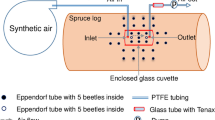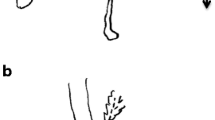Abstract
A recent survey revealed that the newly invasive banded elm bark beetle, Scolytus schevyrewi, was much more abundant than the long-established European elm bark beetle, S. multistriatus, in areas of Colorado and Wyoming, USA. This study was initiated to determine whether competitive displacement of S. multistriatus by S. schevyrewi might be mediated by a sequence of behavioral interactions between the species on and below the bark surface. At the first step in the sequence, host acceptance behavior (i.e., time to tunnel into the host) was monitored among female S. schevyrewi and S. multistriatus. There was no substantial difference in host acceptance behavior when females were offered small cut logs (bolts) of Siberian elm, Ulmus pumila, infested with con- or heterospecific females. At the second step, mating and oviposition usually follow after a female has excavated a gallery. Mean oviposition per parental female in 1 wk was not significantly different among treatments: S. schevyrewi at medium density of 2.86 parental females per dm2, at high density of 5.71 per dm2; S. multistriatus at medium density, at high density; and mixed species (i.e., S. schevyrewi and S. multistriatus combined, with each at medium density). At the third step, progeny production and progeny size were monitored among the same density treatments, but the number of parental beetles and size of bolts were doubled. Differences in progeny production would reflect larval competition, since the number of eggs initially laid was not different. Both S. schevyrewi and S. multistriatus were sensitive to intraspecific competition because size of progeny was smaller in high than medium density treatments, but total progeny production was similar at both densities. Scolytus schevyrewi was a stronger interspecific competitor than S. multistriatus. Smaller S. multistriatus progeny, and four-fold more S. schevyrewi progeny were produced when both species developed on the same host. The contributions of these proximal behavioral events toward the mechanism for competitive displacement are described in the context of the host colonization behavior of Scolytus spp. The competitive advantage of S. schevyrewi larvae established through this study, and the more rapid response of S. schevyrewi to elm hosts established through other investigations, may be the key mechanistic components that facilitate the displacement of S. multistriatus by S. schevyrewi.




Similar content being viewed by others
References
Anderbrant O, Schlyter F (1989) Causes and effects of individual quality in bark beetles. Holarctic Ecol 12:488–493
Anderbrant O, Schlyter F, Birgersson G (1985) Intraspecific competition affecting parents and offspring in the bark beetle Ips typographus. Oikos 45:89–98
Baker J, Norris DM (1968) Further biological and chemical aspects of host selection by Scolytus multistriatus. Ann Entomol Soc Am 61:1248–1255
Bartels JM, Lanier GN (1974) Emergence and mating in Scolytus multistriatus (Coleoptera: Scolytidae). Ann Entomol Soc Am 67:365–370
Beaver RA (1974) Intraspecific competition among bark beetle larvae (Coleoptera: Scolytidae). J Anim Ecol 43:455–467
Bishir J, Roberds JH, Strom BL (2004) On-bark behavior of Dendroctonus frontalis: a Markov chain analysis. J Insect Behav 17:281–301
Browne LE (1972) An emergence cage and refrigerated collector for wood-boring insects and their associates. J Econ Entomol 65:1499–1501
Bybee LF, Millar JG, Paine EO, Campbell K, Hanlon CC (2004) Effects of temperature on fecundity and longevity of Phoracantha recurva and P. semipunctata (Coleoptera: Cerambycidae). Environ Entomol 33:138–146
Cannon WN (1985) Gallery construction and oviposition of Scolytus multistriatus (Coleoptera: Scolytidae) in relation to temperature and adult density. Environ Entomol 14:641–643
Chapman JW (1910) The introduction of a European scolytid (The smaller elm bark beetle, Scolytus multistriatus Marsh) into Massachusetts. Psyche 17:63–68
Claflin LE, Dooling OJ (1973) Dutch elm disease in Montana. Plant Dis Rep 57:701
Cranshaw W, Leatherman D, Kondratieff B (1993) Insects that feed on Colorado trees and shrubs. Colorado State University Cooperative Extension Bull No 506A
DeBach P (1966) The competitive displacement and coexistence principles. Ann Rev Entomol 11:183–212
Doskotch RW, Chatterji SK, Peacock JW (1970) Elm bark derived feeding stimulants for the smaller European elm bark beetle. Science 167:380–382
Drooz AT (1985) Insects of eastern forests. USDA Forest Service Misc Pub 1426
Elkinton JS, Wood DL (1980) Feeding and boring behavior of the bark beetle Ips paraconfusus (Coleoptera: Scolytidae) on the bark of a host and non-host tree species. Can Entomol 112:797–809
Hajek AE, Dahlsten DL (1985a) Insect and mite associates of Scolytus multistriatus (Coleoptera: Scolytidae) in California. Can Entomol 117:409–421
Hajek AE, Dahlsten DL (1985b) Factors influencing the mortality of Scolytus multistriatus (Coleoptera: Scolytidae) in elm branches in California. Can Entomol 117:819–828
Hanks LM, Paine TD, Millar JG, Campell C (1997) Another tree-killing pest of eucalyptus invades California. Calif Plant Pest Dis Rep 16:19–21
Hostetler BB, Brewer JW (1976) Survival of Dendrosoter protuberans, a parasitoid of Scolytus multistriatus, in Colorado. Ann Entomol Soc Am 69:85–88
Hougen-Eitzman D, Karban R (1995) Mechanisms of interspecific competition that result in successful control of Pacific mites following inoculations of Willamette mites on grapevines. Oecologia 103:157–161
Jacobi WR, Kioski RD, Harrington TC, Witcosky JJ (2007) Association of Ophiostoma novo-ulmi with Scolytus schevyrewi (Scolytidae) in Colorado. Plant Dis 91:245–247
Langor DW, DeHaas LJ, Foottit RG (2009) Diversity of non-native terrestrial arthropods on woody plants in Canada. Biol Invasions 11:5–19
Lee JC, Negrón JF, Mc Elwey SJ, Witcosky JJ, Seybold SJ (2006) Banded elm bark beetle—Scolytus schevyrewi. USDA Forest Service, Pest Alert R2-PR-01-06
Lee JC, Haack RA, Negrón JF, Witcosky JJ, Seybold SJ (2007) Invasive bark beetles. USDA Forest Service, Forest Insect and Disease Leaflet Pub 176
Lee JC, Flint ML, Seybold SJ (2008) Suitability of pines and other conifers as hosts for the invasive Mediterranean pine engraver, Orthotomicus erosus (Coleoptera: Scolytidae) in North America. J Econ Entomol 101:829–837
Lee JC, Aguayo I, Aslin R, Durham G, Hamud SM, Moltzan B, Munson AS, Negrón JF, Peterson T, Ragenovich IR, Witcosky JJ, Seybold SJ (2009a) Co-occurence of two invasive species: the banded and European elm bark beetles (Coleoptera: Scolytidae). Ann Entomol Soc Am 102:426–436
Lee JC, Hamud SM, Negrón JF, Witcosky JJ, Seybold SJ (2009b) Differences in semiochemical-mediated flight behavior between the invasive banded and European elm bark beetles (Coleoptera: Scolytidae) in North America: a potential factor in competitive displacement. Chemoecology, in review
Luhring KA, Millar JG, Paine TD, Reed D, Christiansen H (2004) Ovipositional preferences and progeny development of the egg parasitoid Avetianella longoi: factors mediating replacement of one species by a congener in a shared habitat. Biol Control 30:382–391
Moore LM (2003) Siberian elm Ulmus pumila L. USDA NRCS National Plant Data Center, Plant Fact Sheet, http://npdc.usda.gov
Negrón JF, Witcosky JJ, Cain RJ, LaBonte JR, Duerr DA II, McElwey SJ, Lee JC, Seybold SJ (2005) The banded elm bark beetle: a new threat to elms in North America. Am Entomol 51:84–94
Page M, Nelson LJ, Blomquist GJ, Seybold SJ (1997) Cuticular hydrocarbons as chemotaxonomic characters of pine engraver beetles (Ips spp.) in the grandicollis subgeneric group. J Chem Ecol 23:1053–1099
Peacock JW, Silverstein RM, Lincoln AC, Simeone JB (1973) Laboratory investigations of the frass of Scolytus multistriatus (Coleoptera: Scolytidae) as a source of pheromone. Environ Entomol 2:355–359
Pureswaran DS, Borden JH (2003) Is bigger better? Size and pheromone production in the mountain pine beetle, Dendroctonus ponderosae Hopkins (Coleoptera: Scolytidae). J Insect Behav 16:765–781
Readio PA (1935) The entomological phases of Dutch elm disease. J Econ Entomol 28:341–353
Reid ML, Roitberg BD (1995) Effects of body size on investment in individual broods by male pine engravers (Coleoptera: Scolytidae). Can J Zool 73:1396–1401
Reitz ST, Trumble JT (2002) Competitive displacement among insects and arachnids. Ann Rev Entomol 47:435–465
Safranyik L (1976) Size- and sex-related emergence, and survival in cold storage, of mountain pine beetle adults. Can Entomol 108:209–212
SAS Institute (2007) JMP® 7.0.1. SAS Institute, Cary
Švihra P, Clark JK (1980) The courtship of the elm bark beetle. Calif Agric April: 7–9
Švihra P, Koehler CS (1982) Attack and development of Scolytus multistriatus in small-diameter elm branches. Environ Entomol 11:594–597
Wallin KF, Raffa KF (2000) Influences of host chemicals and internal physiology on the multiple steps of postlanding host acceptance behavior of Ips pini (Coleoptera: Scolytidae). Environ Entomol 29:442–453
Wang A (1992) Scolytus schevyrewi Semenov. In: Siao G (ed) Forest insects of China. China Forestry, Beijing, pp 633–634 in Chinese, translated by H. Liu
Wood DL (1982) The role of pheromones, kairomones, and allomones in the host selection and colonization behavior of bark beetles. Ann Rev Entomol 27:411–446
Wood SL (2007) Bark and ambrosia beetles of South America (Coleoptera, Scolytidae). Brigham Young University, M.L. Bean Life Science Museum, Provo
Acknowledgements
We thank D.L. Wood for a critical review of the manuscript, and the following people for laboratory assistance, or for providing fresh elm logs or rearing equipment: T. Eifler, S. Hishinuma, W. H. Sze-To, C. Wang, T. Young (all UC Davis); S. Hamud (USDA Forest Service); K. Daane (UC Berkeley); and S. Churchillo (Reno Parks and Recreation). Funding was provided by USDA NRI CSREES Grant 2006-35302-16611, USDA Forest Service, Special Technology Develop. Prog. Grant R2-2004-05, USDA Forest Service Pacific Northwest R6 Forest Health Protection, and the USDA Forest Service Pacific Southwest Research Station. We also thank D. Ullman, S. Padgett, and L. Beneze at the UC Davis Department of Entomology, for administrative support.
Author information
Authors and Affiliations
Corresponding author
Rights and permissions
About this article
Cite this article
Lee, J.C., Seybold, S.J. Host Acceptance and Larval Competition in the Banded and European Elm Bark Beetles, Scolytus schevyrewi and S. multistriatus (Coleoptera: Scolytidae): Potential Mechanisms for Competitive Displacement between Invasive Species. J Insect Behav 23, 19–34 (2010). https://doi.org/10.1007/s10905-009-9192-1
Revised:
Accepted:
Published:
Issue Date:
DOI: https://doi.org/10.1007/s10905-009-9192-1




